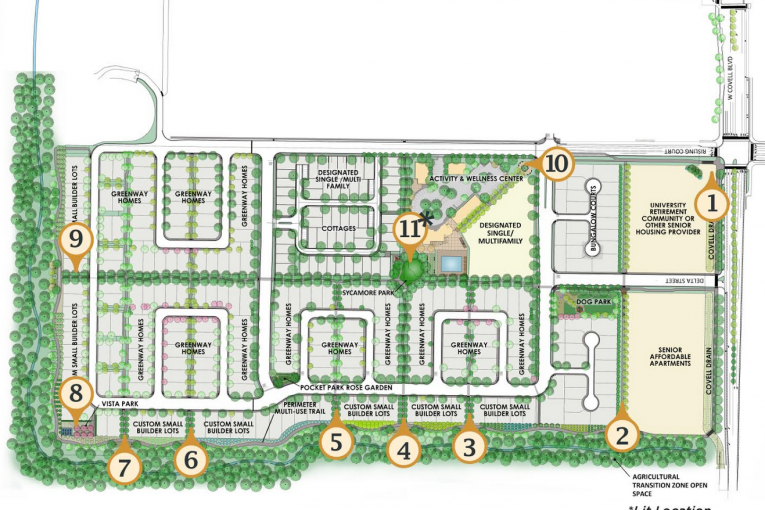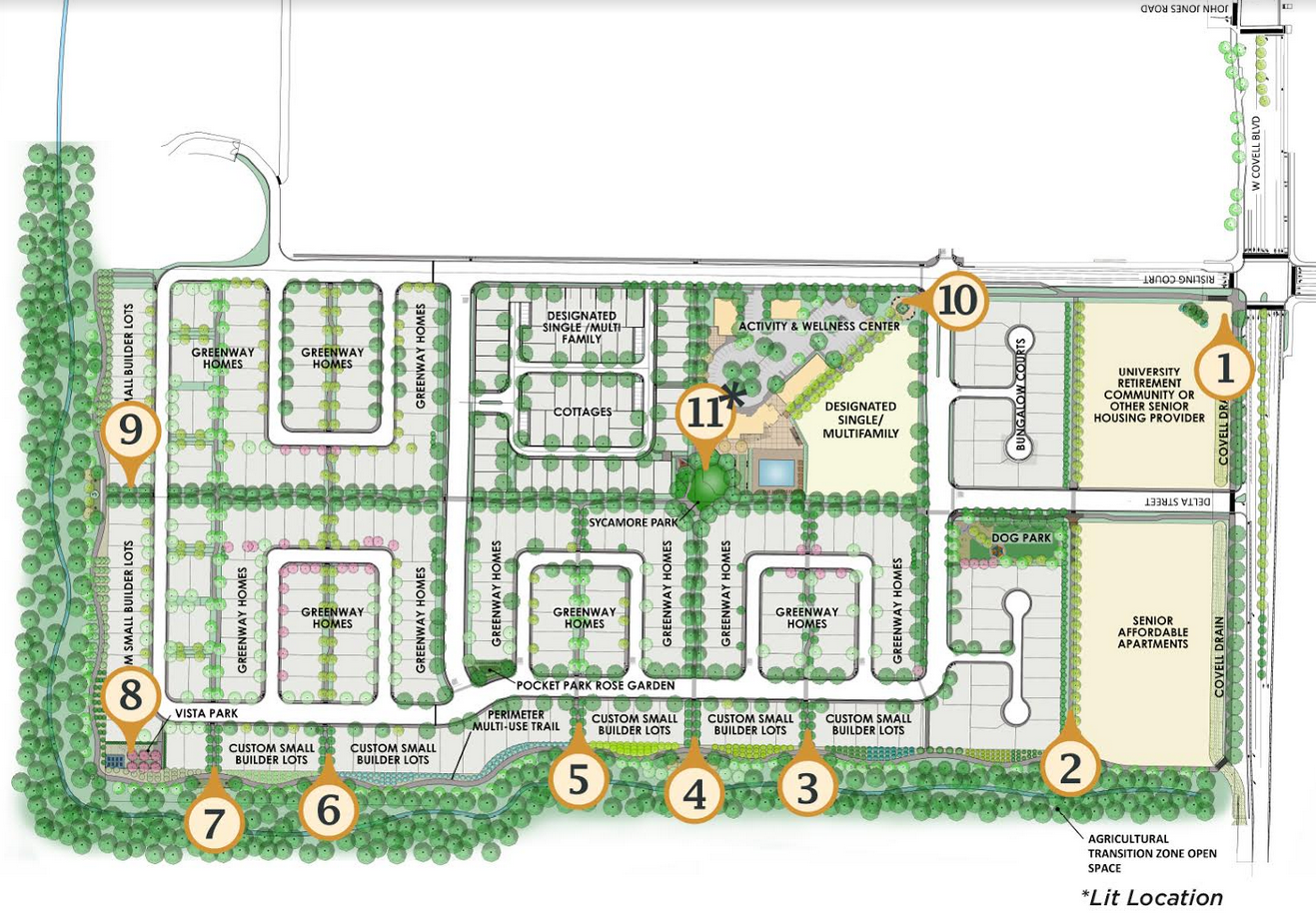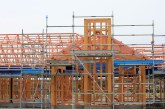

By David M. Greenwald
For better or for worse, the Cannery project has become the local poster child case on the laws’ unintended consequences and the need to ensure accountability by the city for project developers. I was an opponent of the project as it seemed expensive and largely attracted Bay Area transplants rather than addressing local housing needs.
To be clear, there is nothing wrong with people from the Bay Area moving to Davis in search of more affordable housing, the issue rather is that we had existing internal housing needs that largely went unfulfilled by this project.
It is ironic that Bretton Woods is rapidly becoming the Cannery of Measure J projects because, in a lot of ways, the developer Dave Taormino designed the Davis-Based Buyers Program in an attempt to avoid the problems that befell Cannery. Their hope was to create housing that people living in Davis could downsize to and thereby free up housing for younger families in other parts of town.
One of the problems is that it was never clear that the program they designed was ever going to pass legal muster and the city, rather than attempting to address that issue up front they simply cut off discussion—washed their hands of it… legally speaking at least.
The language in the development agreement was designed to both indemnify the city from future legal action and also ensure that the project and the program followed “applicable fair housing laws.”
As Assistant City Manager Ashley Feeney told me a few weeks ago: “This an applicant program that they elected to do and was included in the DA to ensure follow-through on the commitment as Dave Taormino continued to talk about it throughout the approval process but it was his program not something the City initiated.”
He said, “At the time of approval of the project, the City avoided taking on any approval or disapproval role over the program because of concerns that it can be difficult to operate a local  buyers’ program in compliance with state and federal Fair Housing Requirements.”
buyers’ program in compliance with state and federal Fair Housing Requirements.”
That being true, wouldn’t it have been better to have addressed these issues up front?
As it stands now critics are charging “bait and switch.”
Alan Pryor writes: “The Bretton Wood developer, David Taormino, is attempting to pull another bait and switch on Davis seniors by completely gutting the campaign promises he made to Davis voters committing to sell 90% of homes in the new project to Davis-based buyers.”
He charged “make no mistake about it, this newly proposed watered-down plan has so many loopholes in it that it will open the floodgates to advertising and sales to well-heeled Bay Area expatriates flush with cash from sales of their own inflated homes.”
Planning Commissioner Darryl Rutherford is probably closer to my view, “I don’t necessarily agree with some of the comments that this is a bait and switch, I think this is more of a project that’s trying to maintain fidelity to fair housing law but doing it in a way that’s pretty weak and lacking creativity and ingenuity in creating a program that a majority of voters I think were anticipating while addressing fair housing law.”
But, make no mistake, there is a real danger and I think the letter to the Enterprise by Elaine Roberts-Musser brilliantly points out the danger here.
The problem that the city faces is now the ballot language in the Measure L proposal: (the city needs) “an adequate housing supply to meet internal city needs … 90 percent of the home sales will be limited to Davis-connected buyers.”
The city itself said this of the project: “The project proponent has elected to develop a Davis-Based Buyers Program? that would restrict sale of 90% of the for-sale residential units to households that include a Davis resident, family of a Davis resident, Davis employee, student or graduate of Davis schools, or similar connection. The Development Agreement requires the developer to develop requirements and procedures for the program that ensure that it is consistent with all applicable fair housing laws. The developer is still in the process of preparing program criteria, which must be submitted to the City prior to the issuance of any building permits for the project.”
But Musser charges, “The developer has now reneged on that promise.” She notes, “The plan is rewritten so anyone who has a marital status, or does/doesn’t have a family, or has a sexual orientation, or race, or gender, or some views on religion — doesn’t need a connection to Davis!”
As she writes, “The city refuses to prevent the evisceration of this program.”
There is a real danger here, as Musser herself articulates. She writes that “anti-growthers will have the ammunition necessary to discourage development” and “citizens are unlikely to vote for another Measure R project.”
In other words, this becomes the Cannery of Measure J projects—the poster child for why we can’t trust the developers or, in fact, the city.
As Musser points out, “This issue is much larger than just Bretton Woods. It is a matter of basic fairness. Developers should be made to keep their word — it is a legal requirement of California election law.”
This is a real dilemma for the city. Up until now they have punted on addressing these issues, but the council needs to step up and show some leadership or Elaine Roberts-Musser will be proven correct—the community will not be willing to pass future projects.
—David M. Greenwald reporting
Support our work – to become a sustaining at $5 – $10- $25 per month hit the link:







As I have written at length on numerous occasions, the buyers program would in no way accomplish its purported purpose and would, in fact, exclude buyers who do have connections to Davis (e.g, people who live beyond the city/school district limits but who shop in Davis, provide goods or services to Davis residents/businesses, etc.).
It’s not a bait and switch. It’s a case of selling a product with inherent and irremediable design flaws that was defective from the start. It’s only in the Development Agreement, which, by law, can be amended without a public vote. It can’t be mended; it should be ended.
So, “which” is it?
Are you claiming that if a particular (somehow “cheap”?) type of housing is built, then (somehow) it will only attract “locals”? What is this claim based upon?
Their “hope” was to gain approval for the proposal. As I recall, it was predicted that they’d drop this program after gaining approval.
But going back to the first comment, why would anyone assume that the housing which is “freed-up” by WDAAC wouldn’t have the same “problem” as The Cannery?
Not arguing, but looking to ‘clarify’… definitions can be ‘fungible’…
Does relatively inexpensive housing (ex., vs Bay Area), combined with an employment opportunity in Davis [like a career ‘promotion’], where the folk seeking both, and having attended UCD, then returning to their Bay Area ”home turf”, realizing that there was little chance for affordable home ownership there… then realizing as they were starting a family that they’d rather work in the Davis community, live there, raise a family there… was such housing serving the “locals” (who have now been part of the community for over 40 years) or “out-siders”?
The focus of “local housing needs” in the discussion does not seem to distinguish between folk who are already here, or those who intend to be “locals”… just an observation…
Bretton Woods is far from being a great project (I voted against it), but the fascination with the ‘buyer’s’ program, vs the likelihood of a proposed developer CFD, or ‘general public’ expenditures to finance the infrastructure that WAS definitely defined in the DA, and the “project” ‘baseline features’…
Folk seem to be focusing on the gnat on the back of the elephant, not the elephant…
I don’t think you really understood my comment when you asked “which is it”.
“Are you claiming that if a particular (somehow “cheap”?) type of housing is built, then (somehow) it will only attract “locals”? What is this claim based upon?”
No. I’m not. I’m claiming that we had internal needs not fulfilled by Cannery. WDAAC attempted to address those needs but did so in a flawed way.
Seems to me that The Cannery is exactly the type of housing that would appeal to families (a supposed “internal need”), and is exactly the type of housing that would be proposed as a peripheral development.
It’s also similar to the type of housing that’s being built in Spring Lake, which is accommodating much of that same, claimed “internal need”, as well as Bay Area transplants. (Actually, I don’t even know what you mean by “internal need”. Bill asked a similar question.)
What part of The Cannery “doesn’t” appeal to local families?
And perhaps more importantly, how do you “keep out” non-local families (since that’s your implied goal) regarding this type of housing?
No it isn’t. It’s not at all what families are looking for. It’s a lovely retirement community.
[edited]
A good portion of The Cannery is single-family dwellings, but with yards that are smaller than average.
What, exactly, does [edited: Don] (or David) propose as “being what families” (local, or not) “want”? And, what is your basis for that claim?
And why is it that the housing that is supposedly “freed-up” by WDAAC claimed to be appealing to local families, while developments such as The Cannery are not?
Why do you suppose that Spring Lake is selling well?
Spring Lake is selling well because they have large lots, large back yards, and presumably larger floor plans. For the dollars spent, you can get a lot more house and yard in Woodland and the new subdivision in Dixon than you can in Davis. The Cannery has very few units that meet the needs of younger homebuyers.
Shifts in preferences 2020 and on include:
New construction preferred
Outlying suburban location
“For younger buyers, larger homes and better neighborhoods ranked higher, while for older buyers, home features were the main drivers of a move up in price.”
“Quiet neighborhoods, larger homes, access to nature and the outdoors and proximity to amenities ranked higher [in home buying preferences compared to previous surveys]. In keeping with these changes, respondents to this summer’s survey indicated that they are more willing to spend longer times commuting to work in a post-pandemic era. While 52 percent stated that they expected no impact on commute times, 36 percent indicated that they were more willing to either commute longer or live farther from work.”
“For most buyers, price range, number of bedrooms and bathrooms, a renovated kitchen and a large backyard, along with a garage are the primary home features which have not changed during the pandemic.”
You’re telling us that the housing would no longer be restricted, based upon some arbitrary, discriminatory factor? Oh my god – how “unfair”!!!
There’s that “word” again!
Ron
Your missing Elaine’s basic point – the ballot language approved by the City includes the restriction that 90% of the housing goes to Davis connected buyers with NO exemptions. Whether that policy is fair or not isn’t relevant from a legal standpoint. The approval is legally bound by that specific language and if that ballot language is not adhered to, the project loses its approval, regardless of whether a change makes the situation more fair or less arbitrary.
I voted for the project on the basis of this commitment because we need to encourage seniors to downsize and open up housing to families. If the project had a different set of features I might have voted for it, but those features weren’t offered at the time. (Since then, Taromino has said that the houses will be all-electric, conforming with the City’s new code, which would make if more acceptable to me, but they were resistant to that suggestoin at the time.)
Cite the section of ‘California election law’ (challenge to Elaine, and anyone who quotes that!)… that is a patently untrue statement, assertion…
Fairness, perhaps… but what in life is fair? Certainly, not ‘contracting diseases’, ‘personal biases’, and definitely not drafting of laws, nor elections…
We do the best we can, to have ‘level playing fields’, but that is no guarantee… I add, “fair” is in the eye of the beholder… too many examples of that, won’t even start… law, particularly contract law, can be adjudicated… but that process may or not be “fair”… to those who differ in the conclusions…
Developers should not misrepresent the purpose or effect of projects. If, on the other hand, a promised project feature turns out to be flawed, or possibly illegal, they shouldn’t be held to it. That’s why laws and contracts are amendable.
The problem was when she added,
Do you agree or disagree with that portion? Please provide cites if you agree… I fully expect no response as you seem to be one of those hung up on the “fairness religion”… and I assert again, ‘fairness is in the eye of the beholder’…
But it gets to, “is it law and legally enforceable?”…
I’m not “hung up” on the fairness thing. My point is that fairness has nothing to do with this. It’s a question of whether the buyers program has been misrepresented as something it is not. It will not meet an internal housing need as claimed. It will have unintended and possibly unlawful consequences. It’s a flawed concept that cannot be fixed and should not be pursued. (A lipstick on a pig kind of thing.)
Who is to make that judgement, especially “flawed”? How is a community to enforce its standards if the developer isn’t to be held to them? They are supposed to do enough due diligence that if they make a promise and they can’t meet that promise, then they lose their shirts. This is how capitalism is supposed to work–we shouldn’t be privatizing the profits and socializing the losses for the wealthy because we most certainly don’t do that for the rest of us.
It doesn’t take any expertise or much effort for anyone to determine that the buyer criteria of the program make no sense and would not serve the represented purpose. They would allow purchases by those with minimal or no connection to Davis and exclude many with extensive connections.
Sounds like something that Davis cannot provide, while nearby communities are doing so.
Sounds like something that Davis cannot provide, especially the “outlying suburban location”.
See response, above.
Yeah, especially if they don’t need to commute every day (due to permanent shifts from telecommuting).
I might add that the “truly” successful ones are going to places like Tahoe, Truckee, El Dorado Hills, etc. While the somewhat less successful are going to places in the valley. The Chronicle had an editorial recently, noting that telecommuting may actually facilitate more sprawl. I believe there is a massive development proposed in Lathrop, for example. (I would provide a link to the Chronicle, but I believe it’s subscription-only.)
I don’t see it as likely that Davis would approve typical sprawl, let alone at a “cheap price”.
However, The Cannery comes pretty close to meeting the description you provided. Assuming that you’re (still) claiming that The Cannery does not appeal to families, you’re nevertheless still declining to put forth the type of proposal that you believe “would” appeal to families (local, or not), given the criteria you’ve listed. Assuming that you think that Davis “should” do so, in the first place.
My fifth comment.
There are not zero families in The Cannery, but there are not very many.
I have previously stated on several occasions that Davis needs to add a new subdivision, and that the likeliest location for such a housing subdivision would be the northwest quadrant (the area west of WDAAC). My opinion is that it should focus on single-family homes with yards, with the usual extra effort to provide some higher-density, lower-cost housing and some kind of set-aside for a non-profit organization to build some actual affordable housing.
More than happy to continue this discussion another time.
Don… theoretically, that makes sense…
But from a practical, engineering, reality sense, it does NOT…
Most logical places are the “Covell Village” site or the area under the “Mace Curve”… or the site just east of Mace, between Covell and Second/CR 32-A
Has to do with access infrastructure, sanitary sewer, drainage… and soils…
The Bretton Woods site has significant issues, compounded for a site west of that…
I don’t believe in growth without purpose….I also don’t believe in half measure private and public projects. So I don’t get this project as a weird locals only quasi-affordable housing/retirement community project. As usual Davis gets caught up in the socio- politics of wanting to protect local Davisites while being inclusive to all…two mostly mutually exclusive agendas.
But as to families in the Cannery:
From the posts from a Facebook group about families in the Cannery
-Lots of kids
-There are lots of kids in the Cannery. We’re very happy here. There’s a couple houses on the market.
-My parents live there. Lots of kids! The parks are great, and the pool is fantastic, though it hasn’t reopened yet during the pandemic.
-Loads of kids, lots of park space, food trucks every Thursday… what more could you ask for?
-Everything stated above. We’ve been in the Cannery for four years now. The friendly neighbors, adults and kids, make living here very pleasant.
-Pros: Close to Nugget, dog park, multiple playgrounds for kids, yes there are lots of kids there! Cons: The high density, though much appreciated, can feel cramped. Yes, there is a lack of shade trees because it is so new. Once they’ve had a few years to grow it will get better.
-We moved here almost three years ago and love it. Especially our street. We have about 20 kiddos on our street alone and we always celebrate the kiddos birthday with a garage party. Are some pictures from our neighbor get together last weekend.
-We have lived in the Cannery almost 3 years and are very happy here. We love that there are so many kids in the neighborhood and we have the most wonderful neighbors. Sometimes we wish we had a backyard, but most of the time we don’t. Although we miss mature trees, it’s nice having a new home! The location in Davis is great and we are able to bike to many places.
-We live on the west side of the cannery, far side from the train tracks near the urban farm and don’t notice the trains. I think our street is opposite of Carolina’s- we’re kinda the party streets of the Cannery
-lots of kids in the cannery! we didn’t have the badnwidth for a remodel (two FT working parents and 3 kids under 5 at the time), which most of the older homes required when we were looking. we also appreciate the conveniences of modern home design like energy efficiency, tons of storage etc. Please know that cannery homes are flying off the market. Like 10 offers on the day of the one and only open house day- if you are looking at buying. the taxes are tough, i’m not going to lie, but it was/is still cheaper than a remodel or the constant drip of remodel projects.
https://www.facebook.com/groups/1665376657082210/permalink/3069781843308344
The Cannery isn’t my thing. It’s a half measure of a neighborhood quasi-urban community. Not dense enough for me that would allow me to walk to restaurants, the corner store, bars and entertainment. But too dense that I can’t enjoy my space….also I don’t care for the lack of mature trees/ lack of shade and how it feels cut off from the rest of Davis…a tunnel under the tracks to the North Davis Greenbelt would go a long way for me.
Growth isn’t a choice. Growth happens, all around us. We either deal with by putting up barriers, causing insane rents and property values and making the haves richer, or we deal with it by expanding massively out or up. Because up is hard and out is destructive to farmland, and we have 80% Measure JeRkeD, Davis has f¨cked its renters and will never be anything but a rich enclave in a sea of growth, taking advantage of mommy and daddy’s money and JeRkeD to keep rents high.
Growth isn’t a choice? Really? Hmmm…..let me take my time machine back 10-20 years to tell that to the NIMBYs that killed some residential projects of mine or ones I was involved with. What do you think Measure J is but a tool to prevent growth…which is a CHOICE?
You seem to have a problem with the people in a community choosing if expending the resources to grow is worth it to them. Do you believe that communities should just grow and let everyone in without a beneficial plan to the existing community?
You are defining growth as what Davis allows. I am defining growth as the pressure all around us.
I believe countries have the right to choose to grow, and should have a beneficial plan for the existing country. That includes allowing growth by not controlling it, and/or allowing unlimited growth by making that decision. Those are all choices, if the former more choice by making no choice.
A truly Davis-global-centric comment. We’re far from the center of the world. To the Bay Area and the rest of California, Davis is an outlying suburban location less than an hour from the East Bay located on both the major east-west interstate and the Capitol Corridor rail line. Even for Sacramento, we are an outer suburb akin to Elk Grove and Roseville. Davis is clearly in line to be the target of precisely those who want to move in the situation that Don has described.
“What do you think Measure J is but a tool to prevent growth…which is a CHOICE?”
Its been successful at preventing growth too.
What is all this internal needs nonsense anyway? We live next door to an internationally recognized world class public university. People move here from where? Oh the horror! Were any of the people talking about internal needs born here. I bet there are few if any.